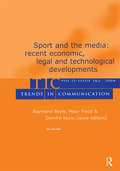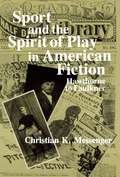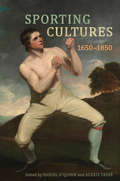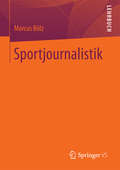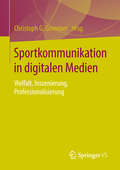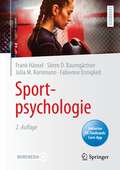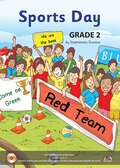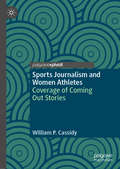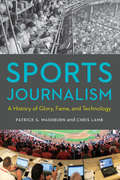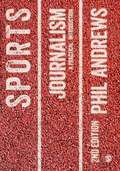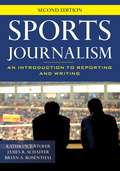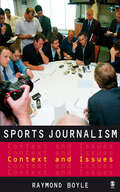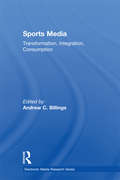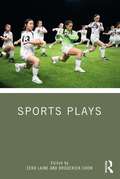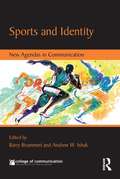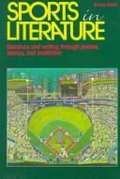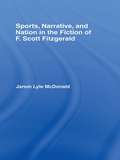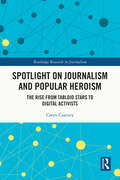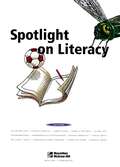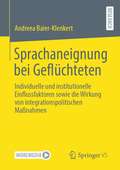- Table View
- List View
Sport and Identity in Ancient Greece
by Zinon PapakonstantinouFrom the eighth century BCE to the late third century CE, Greeks trained in sport and competed in periodic contests that generated enormous popular interest. As a result, sport was an ideal vehicle for the construction of a plurality of identities along the lines of ethnic origin, civic affiliation, legal and social status as well as gender. Sport and Identity in Ancient Greece delves into the rich literary and epigraphic record on ancient Greek sport and examines, through a series of case studies, diverse aspects of the process of identity construction through sport. Chapters discuss elite identities and sport, sport spectatorship, the regulatory framework of Greek sport, sport and benefaction in the Hellenistic and Roman world, embodied and gendered identities in epigraphic commemoration, as well as the creation of a hybrid culture of Greco-Roman sport in the eastern Mediterranean during the Roman imperial period.
Sport and the Media: Recent Economic, Legal, and Technological Developments:a Special Double Issue of trends in Communication
by Raymond Boyle;Peter Flood;Deirdre KevinSport and the Media examines how reliable sportscasting is in the anchor role, reviews the development of sportscasting and specialized sporting services as a response to audience demand, and questions how well the sporting enthusiast--the fan--is being served by later, unanticipated developments. While sport has had a long symbiotic relationship with communication systems, the advent of a digital media age has intensified that relationship, giving evidence of both continuity and substantial change in this relationship as both media systems and popular culture have entered a new century. Collectively, the articles give an authentic flavor of the issues--real and incipient--surrounding sports broadcasting, the media, and the audience as the next round of media consolidation and investment appears to be starting. In particular, they pose questions as to whether sports as a 'killer application' has actually encountered some natural limit, and whether the audience at-large has been well served within the more recent developments.
Sport and the Spirit of Play in American Fiction: Hawthorne to Faulkner
by Christian MessengerIn this comprehensive and insightful study, Christian K. Messenger contends that American writers have always created characters at play in the sure knowledge that to be active in sport in America is to be in touch with its people, their traditions, and their fantasy lives.This is the first inclusive critical study of sport in American fiction with chapters on individual authors such as Hawthorne, Lardner, Fitzgerald, Hemingway, and Faulkner, as well as studies of sport in the literature of the frontier and in boys' formula fiction. A work of literary criticism, Sport and the Spirit of Play in American Fiction also draws on the cultural history of American sport and leisure and on a century of American literature.
Sporting Cultures, 1650–1850
by Daniel O'Quinn Alexis TadieIn the eighteenth century sport as we know it emerged as a definable social activity. Hunting and other country sports became the source of significant innovations in visual art; racing and boxing generated important subcultures; and sport’s impact on good health permeated medical, historical, and philosophical writings. Sporting Cultures, 1650–1850 is a collection of essays that charts important developments in the study of sport in the eighteenth century. Editors Daniel O’Quinn and Alexis Tadié have gathered together an array of European and North American scholars to critically examine the educational, political, and medical contexts that separated sports from other physical activities. The volume reveals how the mediation of sporting activities, through match reports, pictures, and players, transcended the field of aristocratic patronage and gave rise to the social and economic forces we now associate with sports. In Sporting Cultures, 1650–1850 , O’Quinn and Tadié successfully lay the groundwork for future research on the complex intersection of power, pleasure, and representation in sports culture.
Sportjournalistik
by Marcus BölzDer Band bereitet die systematisch und empirisch fundierten Ergebnisse der Sportjournalistik didaktisch auf: Wie die Arbeit der Sportjournalisten konkret aussieht, welche Rahmenbedingungen diese Arbeit prägen und wie Akteure und Rezipienten sportjournalistische Medientexte herstellen, distribuieren und rezipieren. In dem Buch werden dazu die wichtigsten Modelle, Theorien und wissenschaftlichen Befunde dargelegt, anhand von Beispielen der Transfer der Inhalte vom Theoretischen zum Anschaulich-Praktischen vollzogen und die Inhalte und Positionen kritisch reflektiert.
Sportkommunikation in digitalen Medien: Vielfalt, Inszenierung, Professionalisierung
by Christoph G. GrimmerUnter den Perspektiven Vielfalt, Inszenierung und Professionalisierung analysieren Wissenschaftler und Praxisexperten aktuelle Potentiale und Herausforderungen im Bereich digitaler Sportkommunikation. Die Autorinnen und Autoren werfen einen Blick auf verschiedene Sportarten, Nutzergruppen bzw. Kontexte. Nach einer Einführung zur Rolle Sozialer Medien im Sport widmen sich weitere Beiträge der Vielfalt des PR-Einsatzes im Basketball und österreichischen Profifußball. Der Schwerpunkt des Buches liegt auf der Perspektive Inszenierung und fokussiert die darstellerischen Möglichkeiten für u.a. Prominente, Olympioniken und Journalisten. Mit 360 Grad-Videos wird eine bislang in der Wissenschaft weitgehend ausgeblendete Innovation der Social Media-Kommunikation aufgegriffen. Im dritten Teil erhält der Leser vertiefende Einblicke in die durch Soziale Medien beeinflusste Öffentlichkeitsarbeit von Pressesprechern und Kommunikationsagenturen.
Sportpsychologie
by Frank Hänsel Fabienne Ennigkeit Sören D. Baumgärtner Julia M. KornmannDiese Neuauflage des kompakten Lehrbuchs der Sportpsychologie bietet Studierenden der Sportwissenschaft wie auch der Psychologie einen optimalen Überblick. Grundlegende Fragestellungen und Themen der Sportpsychologie werden kompakt und gut verständlich erklärt. Da sich die Sportpsychologie ganz grundsätzlich mit dem menschlichen Erleben und Verhalten in sportlichen Situationen beschäftigt, werden Fragestellungen aus einem breiten Spektrum aufgegriffen. Die Antworten basieren auf der aktuellen Forschung und weisen beispielhaft auf Anwendungen für die Sportpraxis hin. Das Lehrbuch ist hilfreich zur Prüfungsvorbereitung und ein Lesegenuss für alle, die an den wissenschaftlichen Grundlagen der Sportpsychologie interessiert sind. Dazu bietet die inkludierte Flashcard App digitale Frage- und Antwortkarten zum Selbsttest. Zusätzlich finden Sie digitale Zusatzmaterialien auf der Lehrbuch-Begleitwebseite.
Sports Day class 2 - MIE
by Stephanette Ducasse"Sports Day," a vibrant big book by Stephanette Ducasse, captures the spirited atmosphere at Happy Kids School during their annual sports event. The narrative unfolds as students participate in various lively activities and races, cheered on by enthusiastic parents and teachers. From the rabbit-race to the clothing-relay, potato-race, and more, each grade level engages in different games, fostering an air of excitement and camaraderie. As the day progresses, the anticipation heightens until the sports-teacher finally announces the victorious Red Team, igniting cheers and applause among the participants. With engaging illustrations and a dynamic storyline, this book not only celebrates the joy of sports but also encourages young readers to embrace teamwork, sportsmanship, and the thrill of competition in a school setting. Through its interactive sessions and activities, the book aims to enhance literacy skills while relaying the fun and energy of Sports Day at the school.
Sports Journalism and Women Athletes: Coverage of Coming Out Stories
by William P. Cassidy“Women’s sports have typically been grossly under-represented in sports media coverage. Although elite lesbian athletes far outnumber ‘out’ male athletes, media scrutiny of their experiences remains largely non-existent. Largely situated in the context of improved cultural attitudes toward sexual minorities across the West, Bill Cassidy’s Sports Journalism and Women Athletes: Coverage of Coming Out Stories is, therefore, a valuable contribution to the study of sports journalism and media, offering – for the first time – a dedicated and detailed account of the coming out of some of sports’ most high-profile lesbian athletes.”- Dr. Rory Magrath, Solent University, UKThis book examines sports journalism coverage of the coming out stories of three prominent women athletes: tennis legend and feminist icon Billie Jean King, Basketball Hall of Fame Member Sheryl Swoopes and WNBA champion Brittney Griner. When King was outed in 1981 it marked a pivotal moment in which journalists were forced to discuss lesbian athletes in sports for the first time. Swoopes’ 2005 coming out was hailed as a historic moment due to her status as one of the best women’s basketball players of all time, while Griner’s casual public acknowledgment of her sexuality came during what many have called a more receptive environment for gay and lesbian athletes. By directly analysing and comparing the media attention given to these three superstars, Cassidy provides a comprehensive overview of how journalists have historically addressed women and lesbian athletes in professional sports. This book will appeal to readers interested in sports journalism, the role of sport in society, and media coverage of gay athletes.
Sports Journalism: A History of Glory, Fame, and Technology
by Chris Lamb Patrick S. WashburnPatrick S. Washburn and Chris Lamb tell the full story of the past, the present, and to a degree, the future of American sports journalism. Sports Journalism chronicles how and why technology, religion, social movements, immigration, racism, sexism, social media, athletes, and sportswriters and broadcasters changed sports as well as how sports are covered and how news about sports are presented and disseminated. One of the influential factors in sports coverage is the upswing in the number of women sports reporters in the last forty years. Sports Journalism also examines the ethics of sports journalism, how sports coverage frequently has differed from that of non-sports news, and how the internet has spawned a set of new ethical issues.
Sports Journalism: A Practical Introduction
by Phil AndrewsThe sports journalist of today needs to be well equipped for the digital age. From the challenges of minute-by-minute reporting to the demands of writing for online outlets, blogging and podcasting, sports journalism is now fully immersed in new and social media. Sports Journalism: A Practical Guide will give you the skills you need to navigate these new platforms, whilst also teaching you the basics of interviewing, reporting, feature writing for print and commentary for radio and television. This new edition now includes: New examples demonstrating the use of social media in sports journalism A new chapter on the current professional working practice of sports journalism, covering the skills required of agency and freelance journalists today A new chapter on sports public relations Expanded coverage of radio and television sports journalism, with more emphasis on commentary and multi-platform working Quotes from working journalists, offering valuable insights into the industry. This book is a complete guide to the practice of sports journalism across all platforms: print, online, radio, television and social media sites.
Sports Journalism: An Introduction to Reporting and Writing
by Schaffer StoferThe second edition of Sports Journalism: An Introduction to Reporting and Writing has passed the test of time, been used in classrooms internationally, received approval and praise from professors and students, and now it, too, has moved into the new environment of sports media. New chapters on social media and topical issues in the sports world, as well as fresh examples and new references to current technology fill its pages whether you choose to read from a tablet, a Smartphone, a Chromebook or old-fashioned paper wrapped in a cardboard cover.
Sports Journalism: Context and Issues
by Raymond Boyle"Boyle's study is essential reading for all students, teachers and researchers of sports journalism." - Journalism "Very clear and accessible, addressing key and complex issues in a plain and clearcut way." -Alan Tomlinson, University of Brighton Across all media; print, broadcast as well as online, sports journalism has come to occupy an increasingly visible space. This book looks at the institutional, cultural and economic environment and provides an invaluable overview of contemporary sports journalism across all media forms. The book: Situates sports journalism within the broader historical, economic, technological and cultural contexts. Examines the commercialisation of sport and the impact this is having on sports journalism. Looks at the relationship between PR and journalism. Considers the gendered nature of the industry and the impact of digital technology on professional practice.
Sports Media: Transformation, Integration, Consumption (Electronic Media Research Series)
by Andrew C. BillingsLooking toward a future with increasingly hybridized media offerings, Sports Media: Transformation, Integration, Consumption examines sports media scholarship and its role in facilitating understanding of the increasingly complex world of sports media. Acknowledging that consumer demand for sports media content has influenced nearly every major technology innovation of the past several decades, chapters included herein assess existing scholarship while positing important future questions about the role sports media will play in the daily lives of sports fans worldwide. Contributions from well-known scholars are supplemented by work from younger researchers doing new work in this area. Developed for the Broadcast Education Association's Electronic Media Research series, this volume will be required reading for graduate and undergraduate students in media, communication, sociology, marketing, and sports management, and will serve as a valuable reference for future research in sports media.
Sports Plays
by Sports PlaysSports Plays is a volume about sports in the theatre and what it means to stage sports. The chapters in this volume examine sports plays through a range of critical and theoretical approaches that highlight central concerns and questions both for sports and for theatre. The plays cut across boundaries and genres, from Broadway-style musicals to dramas to experimental and developmental work. The chapters examine and trouble the conventions of staging sports as they open possibilities for considering larger social and cultural issues and debates. This broad range of perspectives make the volume a compelling resource for students and scholars of sport, theatre, and performance studies whose interests span feminism, sexuality, politics, and race.
Sports and Identity: New Agendas in Communication (New Agendas in Communication Series)
by Barry Brummett Andrew W. IshakThis volume of essays examines the ways in which sports have become a means for the communication of social identity in the United States. The essays included here explore the question, How is identity engaged in the performance and spectatorship of sports? Defining sports as the whole range of mediated professional sports, and considering actual participation in sports, the chapters herein address a varied range of ways in which sports as a cultural entity becomes a site for the creation and management of symbolic components of identity. Originating in the New Agendas in Communication symposium sponsored by the University of Texas College of Communication, this volume provides contemporary explorations of sports and identity, highlighting the perspectives of up-and-coming scholars and researchers. It has much to offer readers in communication, sociology of sport, human kinetics, and related areas.
Sports in Literature
by Bruce EmraThis compilation includes a variety of genres at 9th through 12th grade reading levels: stories, essays, poetry, and biographies. The selections include notable authors and celebrities including William Wordsworth, John Updike, Lillian Morrison, John Sayles, Chaim Potok, Toni Cade Bambara, and even Abbott and Costello. Sports in Literature will help students see that sport is more than a contest. They will recognize sports as a metaphor for the human experience.
Sports, Narrative, and Nation in the Fiction of F. Scott Fitzgerald (Studies in Major Literary Authors)
by Jarom McDonaldThis study examines the ways that F. Scott Fitzgerald portrayed organized spectator sports as working to help structure ideologies of class, community, and nationhood. Situating the study in the landscape of late nineteenth/early twentieth-century American sport culture, Chapter One shows how narratives of attending ballgames, reading or listening to sports media, and being a ‘fan,’ cultivate communities of spectatorship. Adopting this same framework, the next three chapters explore how Fitzgerald’s literary representations of sport culture express the complexities of American society. Chapter Two specifically considers the ‘intense and dramatic spectacle’ of college football in ‘This Side of Paradise’ as a means of exploring links between spectatorship, emulation and ideology. Chapter Three continues with college football as its theme, but this time looks at how it is portrayed in Fitzgerald’s short stories, in order to scrutinize the relationship between the performative aspects of sport and the performative aspects of social class. Finally, Chapter Four scrutinizes how The Great Gatsby critiques the romantic nationalist ideology of ‘America’s game’ by revealing the class divisions and tensions of baseball’s spectator culture.
Sports-Talk Radio in America: Its Context and Culture
by Frank Hoffmann Jack M. Dempsey Martin J ManningAn inside look at the hosts, hot spots, and history of sports-talk radioSports-Talk Radio in America looks at major-, medium-, and small-market stations across the United States that feature an all-sports format, with a focus on the unique personalities and programming strategies that make each station successful. Broadcasters, journalists, and academics provide insight on how and why this media phenomenon has become an important influence of American culture, examining the "guy talk" broadcasting approach, the traditional sports-emphasis approach, "HSOs" (hot sports opinions), localism in broadcasting, how sports talk radio builds "communities" of listeners, and how reckless, on-air comments can actually build ratings.For better of worse, millions of (mostly) male listeners indulge their obsession with sports to the exclusion of virtually everything else available on the radio dial-music, news, and political talk. This unique book examines how this "niche of the niche" has formed a bond between its hosts and their rabid, passionate, and loyal audiences, spinning the dial from the largest, best-known stations in big-league markets to smaller stations in Collegetown, USA, including Philadelphia&’s WIP, "The Ticket," KTCK in Dallas, WEEI in Boston, "The Team," WQTM in Orlando, KJR in Seattle, KOZN "The Zone" Omaha, Nebraska, WGR and WNSA in Buffalo, Kansas City&’s WHB, and "The Fan," WFAN in New York, the first all-sports radio station and the blueprint for the format. Sports-Talk Radio in America puts you in the studio with Mike and the Mad Dog, Angelo Cataldi, Howard Eskin, "The Musers" ("Junior" Miller and George Dunham), Norm Hitges, John Dennis and Gerry Callahan, Dan Sileo, Howard Simon, and Art Wander. Sports-Talk Radio in America examines: how stations create an environment in which listeners become part of a social group (social-identity and self-categorization theories) personality-driven programming the station&’s commitment to local teams and their fans how exploring controversial topics beyond sports broadens station&’s appeal and attracts upscale, affluent audience how an abundance of live, play-by-play broadcasting, creating plenty of available content college sports in a town without a major professional sports team how local sports is framed by hosts and callers the conflicted relationship between sports-talk radio and the print media and much more!Sports-Talk Radio in America is a must-read for academics and professionals working in radio-television and popular culture.
Spot (Primary Phonics #Set 3 Book 3)
by Barbara W. MakarA systematic, phonics-based early reading program that includes: the most practice for every skill, decodable readers for every skill, and reinforcement materials--help struggling students succeed in the regular classroom
Spotlight Student Book: Grade 1 (Spotlight On English Series)
by SantillanaSantillana Spotlight on English: Academic English for Success in Content and Literacy, Book 1
Spotlight on Journalism and Popular Heroism: The Rise from Tabloid Stars to Digital Activists (Routledge Research in Journalism)
by Caryn CoatneyThis book offers fresh insights into the central role of journalism in shaping popular memories of community heroism in times of crisis. Further, it challenges familiar assumptions about Hollywood celebrity reporting and shows journalists’ active role in connecting popular culture icons with local communities.This book showcases fresh insights into how audiences collaborated and contributed to these widespread stories. The chapters included show how His Girl Friday, a Hollywood classic about tabloid newsroom stars, became a must-see movie for journalists, inspiring hundreds to choose the profession. Other appearances include Peter Fleming (James Bond creator Ian Fleming’s brother) and Norman Rockwell who helped create heroic characters in the news that became global symbols of community leadership. This offers a look at digital news activists who recreated heroic icons in social media to champion human rights in the Middle East. The historical and contemporary case studies offer insights into larger news trends that have contributed to the enduring popularity of these diverse, heroic identities in journalism.Presenting unique views of community, collaborative and interactive journalism, this book will be a valuable resource to students and scholars of journalism, communication, media and political history, as well as professionals already operating within the field of journalism.
Spotlight on Literacy: Level 11 Units 1-6
by Elaine Mei AokiSpotlight on Literacy: Level 11 Units 1-6
Sprachaneignung bei Geflüchteten: Individuelle und institutionelle Einflussfaktoren sowie die Wirkung von integrationspolitischen Maßnahmen
by Andreea Baier-KlenkertGeflüchtete verfügen im Vergleich zu anderen Migrationsgruppen über andere Erfahrungen und individuelle Voraussetzungen zur Sprachaneignung, weshalb eine Vielzahl neuer und zielgruppenspezifisch ausgerichteter Angebote von staatlicher Seite zur Sprachförderung geschaffen wurden. Die Arbeit beschäftigt sich mit der Frage nach dem Einfluss von jenen individuellen und institutionellen Faktoren und dem kausalen Effekt zur Wirkung von integrationspolitischen Maßnahmen und Maßnahmenketten auf die Sprachaneignung von Geflüchteten. Das theoretische Fundament der Arbeit bilden der Rational-Choice-Ansatz, der akteurzentrierte Institutionalismus sowie theoriebasierte Evaluationsansätze, die verknüpft und konzeptionell erweitert werden, um der Spezifität des Untersuchungsgegenstandes gerecht zu werden. Die Analysen belegen, dass individuelle Einflussfaktoren die Sprachaneignung von Geflüchteten zwar maßgeblich beeinflussen, aber auch institutionelle Faktoren bedeutende Faktoren darstellen. Weiterhin zeigt sich, dass integrationspolitische Maßnahmen und Maßnahmenketten zur Sprachaneignung bei Geflüchteten kausal wirken.
Sprachbewusstheit: Perspektiven aus Forschung und Didaktik
by Anja Wildemann Lena Bien-MillerDas Buch verortet das Phänomen Sprachbewusstheit in seiner Vielschichtigkeit und Komplexität. Dabei werden das Themenfeld und der Terminus aus zwei zentralen Perspektiven analysiert und reflektiert: aus der Perspektive des Individuums und seiner sprachlichen und kognitiven Entwicklung und aus der Perspektive der Fachdidaktik und fachlichen Implikationen für den Unterricht. Aspekte von Deutsch als Zweitsprache und Mehrsprachigkeit werden durchgehend berücksichtigt.

